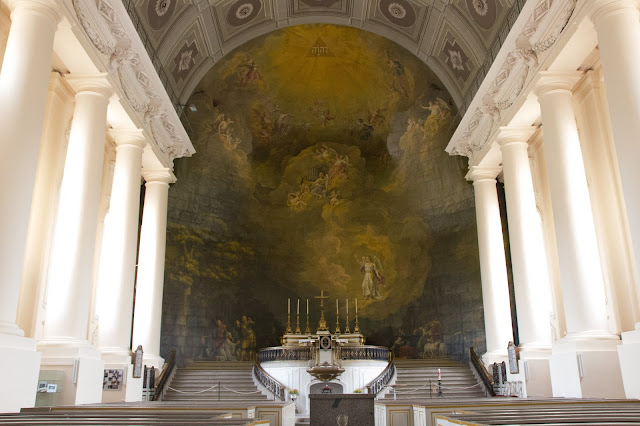Ronnie's dad fought in WWII and spent some of his time in Germany. Based on things he remembered his dad saying, a few letters that he'd written back home to Ronnie's mom, and some in-depth googling, we pinpointed a location where we believe he probably spent some time. Naturally, this was one of the top places on our travel list while they were here.
Our first stop was the Elbe River just outside of the city of Ludwigslust. One of the things we knew for sure was that he crossed this river with his unit before heading to Berlin. We didn't know the exact point where they crossed, but it was still meaningful to walk along side the river.
Next we headed to the Ludwigslust Palace. Originally a hunting lodge, the palace was eventually rebuilt as a luxurious home. Prince Christian Ludwig called the place Ludwigslust or "Ludwig's joy", as he spent much of his time at the hunting lodge. Later the palace was occupied by the Grand Duke Paul Freidrich. In one of the guidebooks we received for our tour of the palace, we learned that it was occupied by Allied forces during WWII. Because Ronnie remembered his dad talking about a beautiful palace or castle and because we know that his unit was in and around the city Ludwigslust, we feel like there's also a very good chance that this would have been one of his locations during the war.
Besides the obvious connection to family history that made this so interesting, the palace itself was incredibly beautiful.
My favorite room was the Gilded Hall which reminded me a lot of the Hall of Mirrors at Versailles. The chandeliers in this room had me mesmerized. To top it off, there was a piano at the far end of the room. Oh, if I could just sit and play music in a beautiful golden room with mirrors and dazzling chandeliers!
In addition to this beautiful reception room, we also got to tour the private chambers of Duke Friedrich.
The second best room in the palace had to be this one. Just look at all the flowers!
The outside garden area was equally as lovely as the palace itself. A very friendly German lady on a bicycle stopped us on one of the trails through the garden and told us that she came and rode the beautiful palace grounds to relieve stress quite often.
In between the palace and the church is a long grassy area that serves as a memorial burial ground for the prisoners of the nearby Wobbelin concentration camp. The camp was liberated by the 82nd Airborne Division in 1945. After mass graves were discovered by the Americans at the concentration camp, the townspeople were forced by commanding General Gavin to rebury some of the bodies in this location.
After strolling through this memorial, we made our way into the church and were completely amazed by what we saw. Unlike anything I've seen in any of the many churches we've been in, behind the pulpit lies a huge painting that's actually part painting and part paper mache.
The Grand Duke Freidrich lies entombed in the middle of the church.
The church organ sits behind this paper mache art, but part of the pipes are incorporated into the painting itself. You can kind of see in this picture that the upper part of this work of art is painted onto the ceiling itself. Where the middle and lower parts look to be 3D is where the paper mache section starts. This was just amazing to sit and gaze upon.
The back of the church looked more like a beautiful theater box than part of a church.
I'm so glad we got the opportunity to visit Ludwigslust. There's so much history in this town and so much beauty as well. It was wonderful to chase down some family history for my brother-in-law. There's nothing quite like walking where the ones you've lost have walked, especially in regards to war time locations. Thanks for letting me be a part of your journey!

















































No thank you for all the research and work you put into it. It would not have been possible wit out you. Something I'll never forget.
ReplyDelete